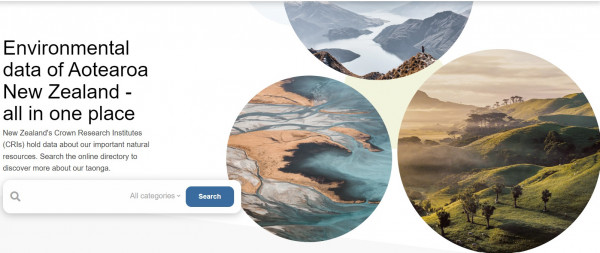Easy access to environmental research data
Identifying unknown organisms, forecasting the weather and understanding the potential impacts of a tsunami. These are all possibilities opened up by a new website that has been built to provide easy access to an enormous range of environmental research data.

New Zealand’s seven Crown Research Institutes (CRIs) have created the National Environmental Data Centre (NEDC) website to make the environmental information held by CRIs more accessible to all New Zealanders.
The datasets include a huge range of information from climate and atmosphere, freshwater, land and oceans, including biodiversity and geological data. They will be of benefit not only to advance science, but also for a myriad of uses by Māori, central and regional government, businesses, researchers and the general public.
“The website demonstrates the active collaboration of our CRIs and the extensive research and development they undertake for the benefit of New Zealand. Bringing all of this freely available research data together creates a significant advantage for all our users,” says John Morgan, Chair of Science New Zealand.
The research data is extensive and, although much of it is already being used, the new website substantially increases accessibility and convenience. It contains a wide variety of tools and resources that range across seven environmental categories from atmosphere to land and ocean.
The “Global eradication and response database - Gerda” – hosted by Plant & Food Research – is a collaborative database that looks at the rates of invasion of unwanted species from around the world. This has been intensified by the increased rates of international trade and travel, by climate change and by the urbanisation of pest species.
“Our Future Climate New Zealand” (Climate change projections) – hosted by NIWA – enables the user to make climate change projections for New Zealand. By employing a range of maps and charts the user can choose from a variety of scenarios to help forecast climate change. Such projections are invaluable for urban planning by central and local governments, and individuals can use the material to better understand the future of a specific region.
The “National Tsunami Hazard Model” – hosted by GNS Science – is an all-encompassing dataset that not only defines the maximum expected tsunami height, but also provides links about tsunami monitoring, tsunami understanding, public awareness and more.
“Biota of New Zealand” – hosted by Manaaki Whenua – is New Zealand’s principal resource for taxonomic information about fungi, land invertebrates and plants, and plant pathogenic bacteria and viruses. This resource plays a critical role in the identification of unknown organisms at New Zealand’s borders. It is also our catalogue of rare and threatened species – an invaluable record of New Zealand’s unique biodiversity.
NIWA’s Chief Scientist, Environmental Information Dr Jochen Schmidt represents the joint CRI Expert Group behind NEDC. “We have populated NEDC with a range of data sources,” says Schmidt, “and we will add more. The website will continue to develop, and the open access will allow better collaboration in the development of top-class data modelling and computer design.
“This is a living data source that will be updated when new information is supplied. It will also ensure any data source remains supported.”
Informatics Team Leader from Manaaki Whenua, Nick Spencer, agrees, and says, “This important collaboration paves the way for the CRIs to provide even greater value from the information we care for on behalf of New Zealand. Making data easier to find and access will support data-led decision making and enable new research insights that will help New Zealand adapt to environmental change”.
The National Environmental Data Centre website can be found at: https://nedc.nz/
Contact
Dr Jochen Schmidt, NIWA +64-27-298-5886
Nick Spencer, Manaaki Whenua Landcare Research +64-21-909-007